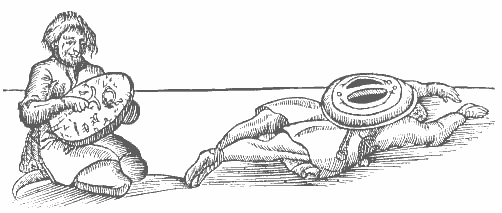

|
Front page Vision and Standards Contents - Finnish Witch Trials - The Wage of Sin is Death Links Contact |
THE SHAMAN'S JOURNEY TO THE UNDERWORLD
© Marko Nenonen

A picture of shamans from a book entitled "Lapponia", originating from 1674 and written by Swedish explorer Johannes Schefferus. While one is beating the witch drum, the other has fallen into a trance, i.e. his soul has travelled to the Underworld. It could be that the other shaman was assisting to induce his peer's soul to return to the world of daylight, or Päivölä, as it is called in the Finnish national epos Kalevala. Kalevala was compiled by Elias Lönnroth in 1835 and 1849 (second full edition). Schefferus' book is also available in Finnish. (Karisto: Hämeenlinna 1963.)
The Finnish word "noita" (witch) originally referred to one who employed the technique of falling into a "lovi" (trance), or an ecstasy ending in fainting. The term "lovi", which literally means a hole or a cut, referred to the gap between Heaven and the Underworld. According to Finnish mythology this gap was the gateway to Hades (Tuonela, Manala). Falling into a trance meant that the soul of the person travels to the Underworld to meet the souls of the dead, who could offer wisdom otherwise unattainable.
The Underworld was governed by the female goddess, known as Pohjolan emäntä (Mistress of the North) or Louhi. (The North was often regarded as a synonym for the Underworld.) It was believed that once at the very beginning of the world the Mistress of the North created all of humanity's adversities - illnesses, crop failures, etc. Shamans and witchdoctors, among them many female witches, were supposed to fight the evil spirits of Louhi. By conjuring or "singing" incantations the seer sends the misfortunes back to the gloomy north, or the Underworld, where they belonged.
Shamanism was a part of the Finns' and Lapps' ancient religion, although among the Finns the tradition seems to have vanished almost entirely before the times of the witch-hunts. Very few shamans appeared at the courts in Lapland, despite the fact that shamanism was still a living tradition, and the area was famous for shamans and witches. Please, see our Synopsis.
Shamanism was in no way the last tradition of great witchdoctors and seers in Finland. Fervent seers who did not dwell in trances or utilise the witch drum in their rituals, were known as intomies or myrrysmies ("enthusiasts" or "witchdoctors"). This culture of seers developed into a dominant culture of soothsaying and magical healing long before the time of the witch-hunts. Anna-Leena Siikala has suggested that the shamanistic witch culture probably survived alongside this new soothsaying culture until well into the Middle Ages.
Ganander, Christfrid, Mythologia Fennica. Åbo - Turku 1789. (Last reprint 1984.)
Nenonen, Marko, Noituus, taikuus ja noitavainot Ala-Satakunnan, Pohjois-Pohjanmaan ja Viipurin Karjalan maaseudulla 1620-1700. Shs: Helsinki 1992, 40-72.
Nenonen, Marko, "Envious Are All the People, Witches Watch at Every Gate." Finnish witches and witch trials in the 17th century. Scandinavian Journal of History. Vol. 18 (1993:1).
Pentikäinen, Juha, The Shamanic Drum as Cognitive Map. The Historical and Semiotic Study of The Saami Drum in Rome. In: Mythology and Cosmic Order. Edited by René Gothóni and Juha Pentikäinen. SKS: Helsinki 1987.
Schefferus, Johannes, Lapponia. 1674. (Finnish translation published in 1963.)
Siikala, Anna-Leena, Shamanistic Themes in Finnish Epic Poetry. In: Mémoires de la Société Finno-ougrienne 194. Helsinki 1986.
Siikala, Anna-Leena, Suomalainen šamanismi. Sks: Helsinki 1992.
